207 SQUADRON ROYAL AIR FORCE HISTORY
Sam Panton
Observer 3/41-5/41 on 207 Squadron
Manchester L7379 EM-T, F/O D Pinchbeck, 2/3 May 1941
Introduction
Sqn Ldr Sam E Panton (RAF Retd) died on 16th February 2003. His daughter, Penny Moir, has provided text and images for this web page:
- an account of Sam being shot down, dictated to a young
member of the family for her school project
- items from his time as a Prisoner of War
- his service record
The Last Flight of Manchester L7379 EM-T, F/O D Pinchbeck
Damaged by flak, crew baled out, pilot force landed near Hamburg - all pow - target Hamburg - 3.5.41
This is the true story of the last flight of Manchester aircraft L7379 of 207 Squadron, RAF Waddington, as told by Squadron Leader S E Panton, who at that time was the Sergeant Air Observer and Bomb Aimer in the aircraft.
We took off at 2200 hours [on 2nd May 1941] and set course for Hamburg leaving the English coast at Yarmouth.
Our target was the industrial area and our bombload a 4000lb [bomb] - the first to be dropped on Germany. The crew consisted of six - five of whom were due for leave on return having completed their tour. I had joined the crew, none of whom I had previously flown with, as a stand-in. My own crew were away on a conversion course to Lancasters.
It was a very dark night and we relied on dead reckoning navigation with some fixes from German beacon stations to assist us. Our engines, two 1000 hp Vultures, went well but the oil pressure fluctuated and we did not obtain our maximum speed. Consequently we were late over the target.
On crossing the enemy coastline we were picked up by the searchlights and had to pass through several flak bands but we got through undamaged. Near to the target at 12000 ft.no other aircraft were to be seen. I noticed that there were very few fires below and thankfully no searchlights. Before bombing I gave our pilot the course out for home and went forward to the nose to the bombing position. Suddenly intense flak buffeted the aircraft and it seemed as if all the searchlights below lit up and coned us. The flak was very accurate and our aircraft was hit several times, I made a quick decision to bomb and did so.
Almost immediately flak hit the bombing panel through which I was looking and splintered it, shattering powdered glass into my forehead.When I turned to go back to my cabin position I looked up and saw that the port engine was on fire with flames streaming back from the cowling. I informed the pilot who, I think, operated the Graviner [fire extinguisher] switch as the flames appeared to abate.
The pilot turned north to pick up the new course for home but could not achieve the new bearing because the rudder was stuck. Then the starboard engine caught fire, with flames creeping along the leading edge to the fuselage.The pilot then gave the order to bale out!
I couldn't see the rear gunner but the rest of the crew were uninjured. I went to the escape hatch and waited for the crew. When I saw the second pilot leaving his seat I opened the hatch and jettisoned it into the night sky. Then I sat on the edge with my legs dangling into space until the rest of the crew appeared and then I baled out. We were at 10,000 ft when we left the aircraft and it took me twenty minutes to make my descent.
I was followed out of the aircraft by three other crew members, that left the pilot and rear gunner. The pilot had difficulties with his parachute and while he was trying to bale out the aircraft was descending rapidly - sometimes on an uneven keel, making his attempts to escape impossible. He soon realised that he was not able to get out and he would have to crash land, in the dark, and most terrifyingly of all, on fire. [In fact his parachute was being re-packed and he was sitting on a cushion - his struggles had been with an observer type harness, unlike the usual pilot harness he wore. As one of the crew baled out he noticed an observer type parachute pack was stowed in the camera hatch.]
When he first hit the ground the undercarriage,which was down,bounced the aircraft over a farmhouse and belly landed beyond it. The pilot jumped out and ran away as the aircraft exploded and burnt out completely.
Meanwhile, unknown to us, the rear gunner had tried without success to get out by way of the rear turret. This failed because the hydraulic system had been damaged. Finally,after many other attempts, he chopped the handle off the door and bailed out at 2,000ft. He landed unhurt. Ironically he realised afterwards that he had tried to open the door outwards but it did, in fact, open inwards and he could have got out first time.
The six crew were taken prisoner and were released four years later.
The crew were:
Pilot F/O D Pinchbeck [Stalag Luft III PoW nr. 636]
2nd Pilot Sgt E A C Lee [Stalag Luft IV PoW nr. 37]
Observer Sgt S E Panton [Camp 357 PoW nr. 28]
W/Op Sgt W Macgregor DFM [Camp 357 PoW nr. 22]
Mid Upper gunner Sgt A S Duncan [Stalag Luft III PoW nr. 20]
Rear gunner Sgt C Barron [Camp 357 PoW nr. 4]
The loss of the aircraft is described in more detail in Dr Bob Kirby's book AVRO MANCHESTER - The Legend behind the Lancaster, pages 65-66.
From Sam's time as a POW
Penny Moir writes: The diaries are written in pencil. Dad always said that they were not allowed to have writing materials so they hid anything that they could find. They are not easy to read at the best of times. Included are a couple of pages from A Book of Prison Camp Sketches acquired by Dad soon after the war and other memorabilia.
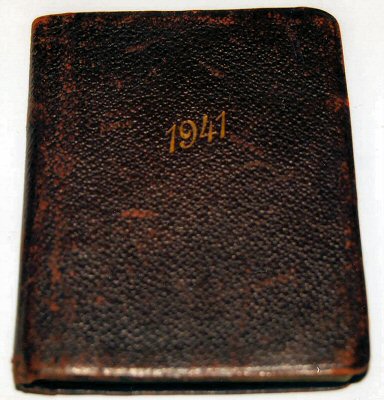
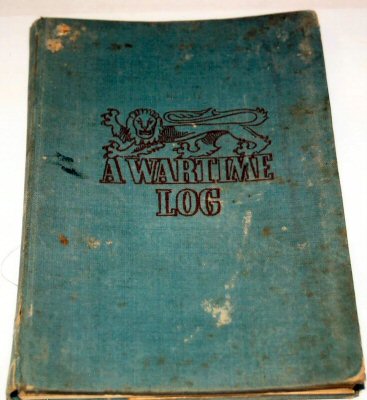
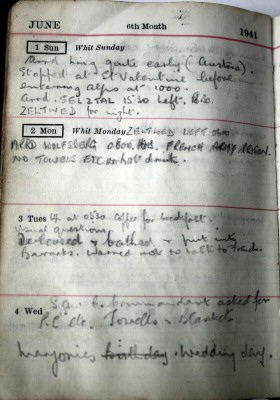 |
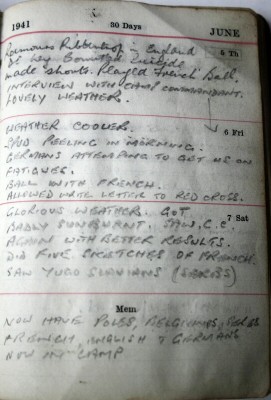 |
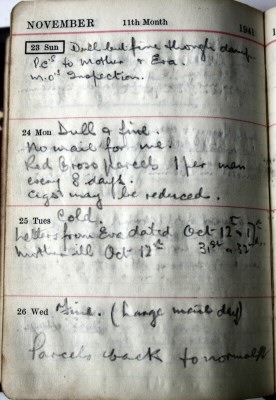 |
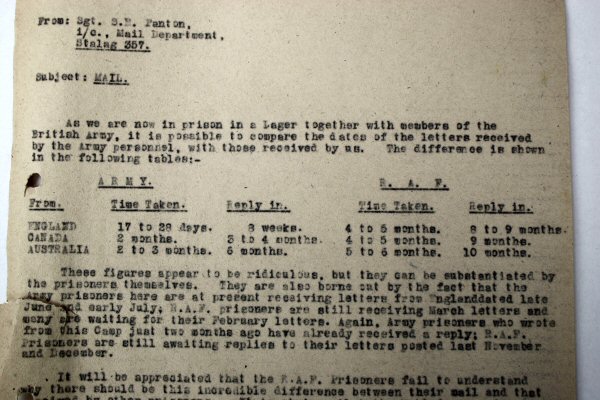
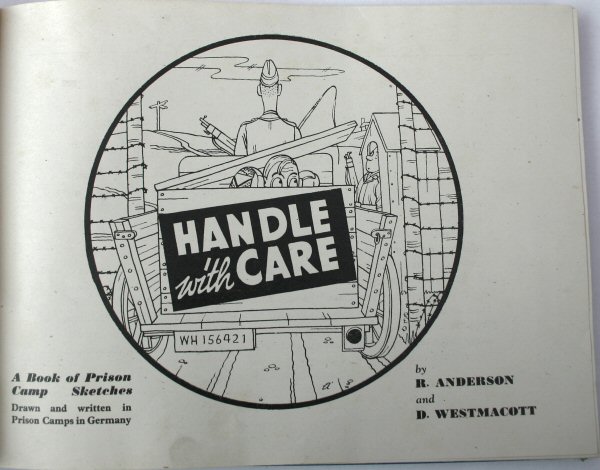
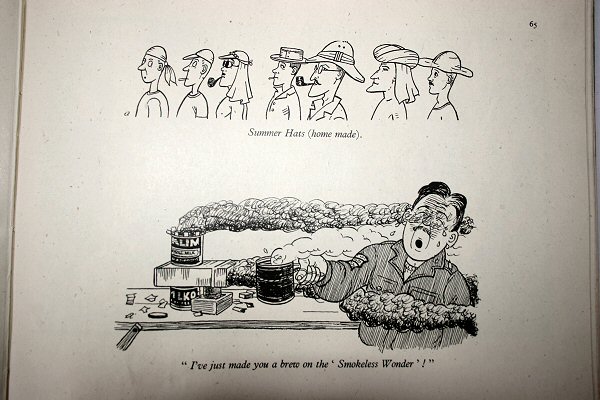
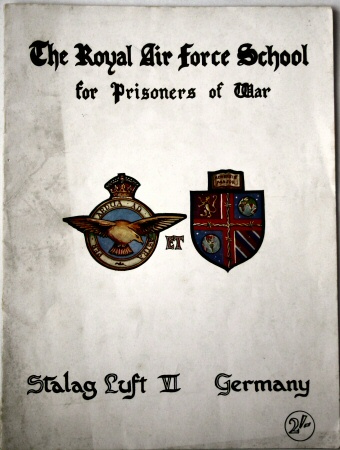
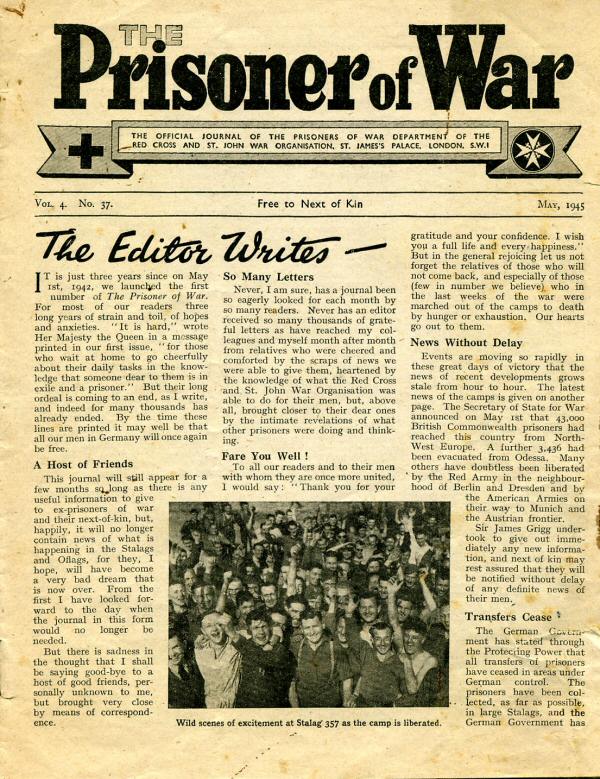
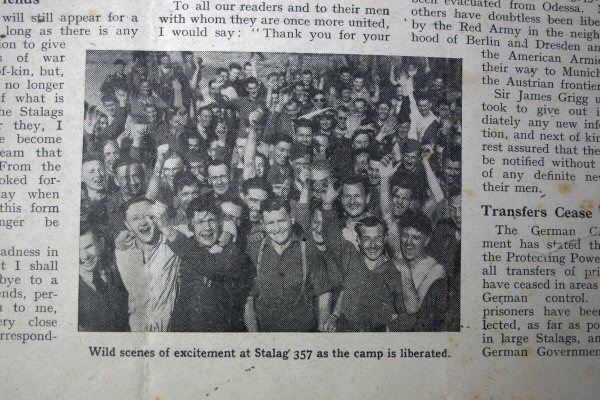
Like many POWs Sam Panton was obliged to trek from his camp westwards in the winter of 1944/45 as the Germans evacuated the camps in the East in their retreat from the advancing Russians. There was real concern that they might begin liquidating the camps - the treks by ill nourished and physically weakened POWs in appalling conditions led to some deaths and atrocities and indeed some cases of losses through friendly fire as the columns were mistaken for retreating Germans.
The Walk as Dad remembered, his spellings:
Saturday 7/4/45 Left Fallingbostal Stalag 357 on foot to Orbke.
8/4/45 Orbke to Becklingen
9/4/45 Becklingen
10/4/45 Becklingen
11/4/45 Main party returned to 357. Small party of 18 returned to Wietzendorf.
12/4/45 Wietzendorf through Traven. 27km. Stayed night in woods.
13/4/45 To Brockofe
14/4/45 To Brockofe.
15/4/45 To Rieste
16/4/45 via Vastoff to Reinstorf.
17/4/45 Reinstorf - crossed Elbe at Bleokade to Buck.
18/4/45 No move.
19/4/45 To Klein Bengensdorf.
20/4/45 To Bennin
21/4/45 To Kolzin
22/4/45 Sunday. Remained Kolzin.
23/4/45 To Rogitz. Remained until 27/4/45.
27/4/45 To Krembz. Remained 28/4/45
29/4/45 To Kittlitz. Released on 3/5/45
Sam Panton's service record
Penny re 'lufy': I have had another look at it in context and feel it could be an abbreviated form of either 'supply' or 'supernumerary'.
RAF NUMBER 58685
Feb 1931-April 1932: Uxbridge (recruit): 54 Sqdn Hornchurch
ACII (GD)
4.4.32-25.5.33 Cranwell: Wireless Ops. Course 3w4.
1933-1934 Manston: W/Op. AC1
1934-1936 47(B) Sqdn Khartoum: W/T & AG : Fairy Gordons
1936-1937 45(B) Sqdn Helwan.W/T & AG.
June-Nov 1936 Palestine: Ramley [Ramlah]: W/T duties.
1937 North Water Fitties: 13 Air Observer Course.
Nov 1937-June 1938 Wyton: 114(B)Sqdn: Air Observer.Blenheims.
June 1938-March 1941 Martlesham Heath: Special Duties Flight:
Blenheims: 401.35 mins.
March 1941-May 1941 Waddington: 207(B) Sqdn: Manchesters.
This was the time when Dad was a prisoner of war. His camps are listed in his writing that he called The Walk.
28/11/46 OCU Cosford. On appt to Com.
4/12/46 Equipment Officer School Hereford: 151 E.O. Course:
Flying Officer.
5/12/46 Hel No.66 Group. Equipment.
10/2/47 Hel Fighter (Cond.?). Equipment
12.2/47 226 OCU Bentwaters. (Lufy?). Equipment.
3/6/47 226OCU Equipment. Flight Lieutenant.
22/10/47-12/11/47 2 School of Admin Hereford. 7 Movements
Officers Course. (Air)
?
4/1/49- 18/1/49 Thorney Island. 8 Course Drill.
9/2/49 15 S of T.T. North Coates. 68 X.F. Course.
30/6/49 No. 94 M.U.Great Ashfield. Equipment X.F. Flying
Officer.
17/5/50 No. 94 M.U.Great Ashfield.Flt.Lt.
30/5/50-19/6/50 Bircham Newton. Man Management. 8 Courses.
14/8/506/10/50 O.A.T.S. 55 Course.
1/1/51 94 MU Equipment E.F. Flt.Lt.
16/3/51 MU Equipment E.F Supernumerary.
31/3/51 El Hamra (Lufy?)
1/4/51 A.H.D. Iraq Lufy
5/5/51 A.H.D. Iraq C.M.T.O.
27/9/52 A.H.D. Iraq Equip. E.4. Sqdn.Ldr.
13/3/53 5 P.D.C. Lufy Equip.
6/5 53 94 M.U. Lufy
20/5/53 94 M.U. S/L Supply "
1/2/56 Hl .no.40 Group Bicester Ops 4Bi
18/8/59 No. 1 Movement Unit (Emb.) Det.Harwich M(H)
Detachment Commander. Sqdn. Ldr.
29/11/61 Retired. Dined out from R.A.F. Hendon
| General Service Medal, with
Palestine clasp 1939/45 Star 1939/45 Aircrew Europe Star 1939/45 War Medal Long Service and Good Conduct Medal |
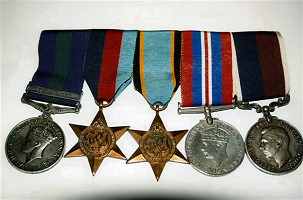 |
Should you wish to make use of any of the information or
images on this page, the right thing to do is to contact the editor
who will pass on your request to Penny Moir.
page last updated 13 August 2008